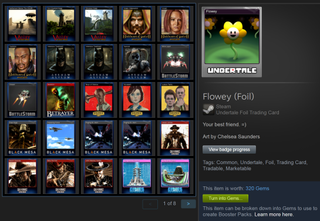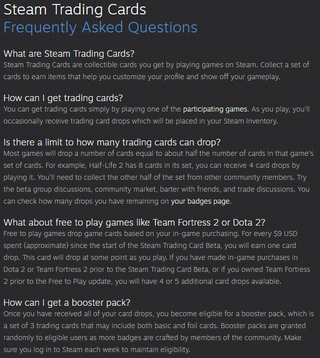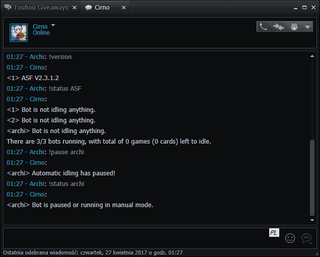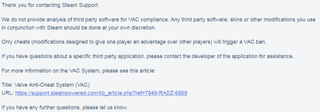How Steam trading card idling works
And will it get you VAC banned?

Believe it or not, some people collect Steam’s virtual trading cards. No, it’s true. The "why" part is as immaterial as the cards themselves. Maybe they build virtual houses with them, or attend Steam card conventions to show off Achievement badges, or Card cosplay as their favorite foil drops. No matter the reason, it’s all cool. Whatever brings the room together, right?
The most obvious reason to collect Steam trading cards, though, is to sell them. People will pay for these cards on the Marketplace, even though they drop for free during games and don’t materially exist, strictly speaking. With most selling for a few cents each, don’t expect retirement money, but since they rain down regularly during gameplay, a large Steam inventory can produce a sizable number of cards for an active player. This can net enough Wallet funds to snag the occasional indie game or sale item.
Or maybe you just like collecting them. But that, too, can have its long-term advantages: by collecting cards and using them to level up your account, you can increase your card drop rate, and earn more money to spend on Steam games.
How Steam idling works

Steam has developed plenty of rules detailing how to get cards, including increased drop rates for high level Steam users.
So short of, you know, actually playing hours of every single game you've accrued in sales and bundles over the years, how else do you get these cards? The utilities of choice for card collectors worldwide are Steam Idle Master and Archi Steam Farm. These simple, free programs log into your Steam account and tell the Steam server you’re playing a game when you’re not.
This accrues card drops the same way loading a game and idling in a safe location otherwise would, only with far less overhead. See, it’s not a hack, you’re saving energy! Steam Idle Master even includes a handy counter that lets you know how many drops are remaining and how long the mini-client has been running.
Which should you use? We'll lay out the details below, but we recommend Archi Steam Farm for your card collecting needs.
Will Steam idling get you banned?
It’s not clear what Valve thinks of this practice, but people have been using Steam idle utilities for years with few issues. Steam Idle Master documentation and FAQs warn of VAC errors if you run the utility along with a secured game simultaneously, so make sure you close out of it and then exit Steam completely before reopening Steam and playing any games protected by SteamGuard.
The biggest gaming news, reviews and hardware deals
Keep up to date with the most important stories and the best deals, as picked by the PC Gamer team.
If the idea of a VAC ban unnerves you, Archi Steam Farm (ASF) avoids Steam Idle Master’s occasional VAC issues by using a different mechanism to trigger card drops. Archi Steam Farm doesn’t require the Steam client running to be active, and supports multiple accounts. It also gets more updates and support to its open source code, so it’s the pick of the two and more popular with the Steam card community these days. Idle Master, in comparison, no longer appears to be supported.

If there’s a drawback to ASF, it’s the command line orientation of the interface. Front end GUIs exist to make things easier, but most interactions are via keyboard using Command Prompt or Steam messaging using bots. It’s not complicated to use or set up, but it is more cumbersome than checkboxes and buttons in a window.
A third alternative, Steam Achievement Manager (SAM), goes beyond the other two and collects in-game achievements as well as cards. As with Idle Master, some users complain that the tool got them banned, while others insist you'll never be touched by VAC as long as you don't run it at the same time as another game.
The creators of SAM and Idle Master warn a ban is possible just to keep themselves clear of any blame, but there doesn't seem to be any hard proof they've ever been responsible for a VAC ban. Just use them wisely.

Minor risks vs. modest rewards
While the risk of lost credentials or VAC banning is small with the right tools, are these utilities worth that extra risk? The answer comes down to how you feel about collecting Steam cards and how you plan your approach to the hobby. If you don’t have even a passing interest in this, then knowing how to game the system more effectively isn’t likely to change your mind. The rewards and mechanics as they currently stand aren’t enough enticement. An actual, playable social game using these cards would be helpful here, raising both the value and the utility of collecting them.
However, if you do enjoy the metagaming aspect as it stands and engage with an active community that shares this interest, the answer is different. Use the right software carefully with a large game library and in short order your inventory will be stuffed with more new cards than you know what to do with. You can use these card-drop windfalls to complete sets and drive up the value or just your own satisfaction, a lot like any collectable card game.
Whether this promotes Valve’s long term social goal of connecting Steam users in communities outside of games is another matter, but don’t hold it against them. Social experiments rarely go as planned; just ask those folks at Stanford.
Most Popular


